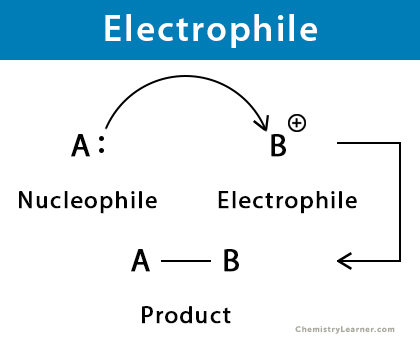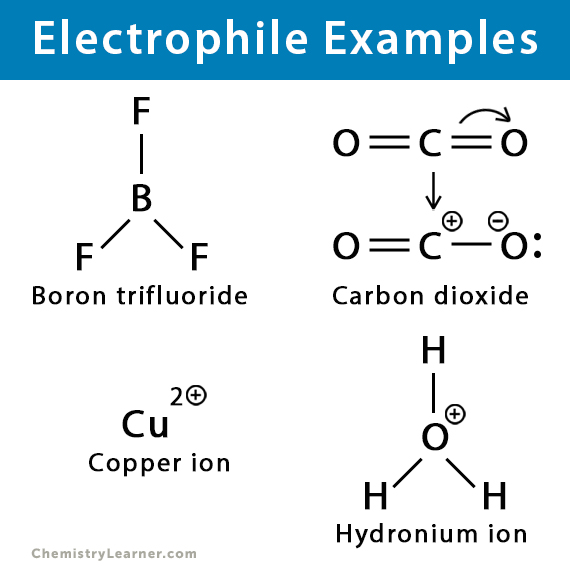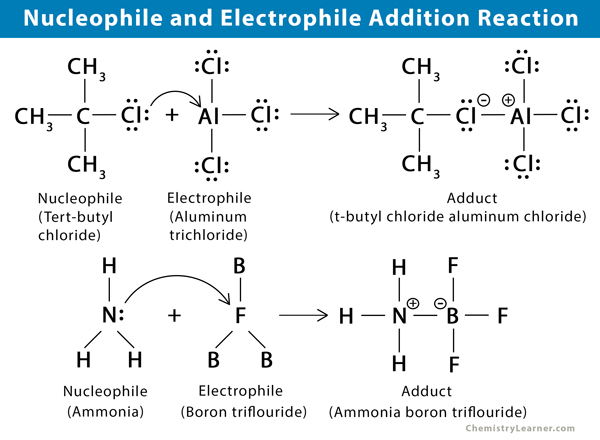Electrophile
What is an Electrophile
An electrophile is a reagent consisting of an atom, ion, or molecule that accepts electron pair to form a bond. It is an electron-deficient species that can be positively charged or neutral with vacant orbitals. An electrophile reacts with a nucleophile by accepting electrons through addition and substitution reactions.
All electrophiles are Lewis acids, but not all Lewis acids are electrophiles.
Electrophile Examples
How to find and identify an electrophile
Here is a list of electrophiles.
- Cations that can accept electron pairs – H+, Mg2+, Fe3+, NH4+, CH
3+,and H3O+ - Molecules with an incomplete octet of electrons – BF3 and AlCl3
- Molecules where the central atom can have more than 8 electrons in its valence shell – SiCl4 and SiF4
- Molecules that can have multiple bonds between two atoms of different electronegativity – CO2 and SO2
Strength of an Electrophile
The strength of electrophile is given by its electrophilicity, which is the ability to attract electrons. Therefore, a positively charged species that requires electrons to obtain stability is a good and strong electrophile. Likewise, a neutral molecule that can create an empty orbital by parting with an excellent leaving group is a good electrophile. For example, a carbonyl (C=O) can add a positive charge to the carbon through resonance. Likewise, a polar compound like alkyl halide can create a proton (H+) since halide is an excellent leaving group.
Electrophilic Reactions
Electrophiles participate in chemical reactions with other compounds. The mechanism of these reactions is such that, first, the electrophile is generated. Then, it attacks a site rich in electrons (e.g., double bond, carbanion). These reactions are known as electrophilic addition and electrophilic substitution reactions.
Electrophilic Addition
An electrophilic species combines with another compound to form a product without losing any atoms present in the reactants.
Examples
- Water adds to ethene to form ethanol
CH2CH2 (ethene) + H2O (water) → CH2OHCH3 (ethanol)
- Bromine adds to ethene to form dibromoethane
CH2CH2 (ethene) + Br2 (bromine) →CH2BrCH2Br (dibromoethane)
Electrophilic Substitution
A chemical reaction in which a functional group from a compound is substituted with an electrophilic species.
Examples
- Electrophilic aromatic substitution: Bromination of benzene results in bromobenzene
C6H6 (benzene) + Br2 (bromine) → C6H5Br (bromobenzene) + HBr (hydrogen bromide)
- Electrophilic aliphatic substitution: Chlorination of acetone results in chloroacetone
CH3COCH3 (acetone) + Cl2 (chlorine) → CH3COCH2Cl (chloroacetone) + HCl (hydrogen chloride)
Nucleophile vs. Electrophile
A nucleophile is a species that is rich in electrons and can donate them to an electrophile. Like an electrophile, a nucleophile can undergo addition and substitution reactions. One can tell if a reaction is electrophilic or nucleophilic by looking at the regents in a chemical reaction. One way to look at the reaction mechanism is to see if the electrons move from the group being added or to the group.
Differences Between a Nucleophile and an Electrophile
| Nucleophile | Electrophile | |
|---|---|---|
| Literal meaning | To love electron | To love nucleus |
| Role | Electron-rich. Donates electrons | Electron-deficient. Accepts electrons |
| Electron pair | Possesses a loosely-held electron pair | Possesses an empty orbital to accept electron pair |
| Charge | Neutral or negative | Neutral or positive |
| Representation | Nu, or Nu– | E or E+ |
| Alternative name | Lewis base | Lewis acid |
| Chemical reactions | Nucleophilic addition and nucleophilic substitution | Electrophilic addition and electrophilic substitution |
| Examples | Chloride ion (Cl–), ammonia (NH3), and carbanion (R’HC–R) | Hydronium ion (H+), boron trifluoride (BF3), and carbocation (R’HC+R) |
FAQs
Ans. During sulphonation of benzene, sulfur trioxide and fuming sulfuric acid are added to the benzene. Hence, the electrophile is the sulfur trioxide (SO3).
Ans. During the nitration of benzene, nitric acid and sulfuric acid are added to the benzene. Hence, the electrophile is a nitronium ion (NO2+).
Ans. Benzene has six pi-electrons that are delocalized around the ring. Thus, it behaves like a rich source of electrons and easily attacked by reagents deficient in electrons, like nucleophiles.







